FAQs about Yellow-Eye, Kole Tangs,
Pathogenic Disease
(plus see
Tangs/Rabbitfishes &Crypt)
Related Articles:
Kole Tangs,
Ctenochaetus,
FAQs on Kole Tang Disease:
Kole Disease 1,
Kole Disease 2,
Kole Disease 3,
Kole Disease 4,
FAQs on Kole Tang Disease by Category:
Diagnosis,
Environmental,
Nutritional,
Social,
Trauma,
Genetic,
Treatments
Related FAQs:
Kole Tangs 1,
Kole Tangs 2, &
Kole Identification, Kole Behavior,
Kole Compatibility,
Kole Selection,
Kole Systems,
Kole Feeding,
Kole Reproduction, &
Ctenochaetus Tangs 1,
Ctenochaetus Tangs 2, &
Ctenochaetus Identification,
Ctenochaetus Behavior,
Ctenochaetus Compatibility,
Ctenochaetus Selection,
Ctenochaetus Systems,
Ctenochaetus Feeding,
Ctenochaetus Disease,
Ctenochaetus Reproduction, &
Surgeons
In General,
Tang ID,
Selection,
Tang Behavior,
Compatibility, Systems,
Feeding,
Disease,
|
|
Kole Tang; hlth., and Cu f'
10/18/17
Good afternoon Crew,
<Dave>
I unfortunately experienced a loss in my tank last night - my Kole tang.
I've had a Kole Tang previously for years... a curious outgoing fish
that was constantly on the move. I have a shallow 60g tank, 79f, 1.024
salinity, no signs of nitrates/nitrites/ammonia - although I have been
purposely
allowing a little hair algae to grow for the upcoming arrival of my Kole
Tang. I'd say overall I feed rather lightly, sometimes every second day
(but am observing my fish growing/fattening up), and only enough that
just
a small amount of thawed frozen Mysis/brine/etc... falls to the
substrate for my snails/crabs/serpent star, etc
I currently have a few corals, bta, two clowns, yellow watchman goby,
royal gramma... I noticed a plump Kole Tang with what appeared to be ICK
at my LFS and offered to buy him at a greatly reduced price because I've
successfully QT and treated ICKY fish with Cupramine in the past, and
without losses. The Kole Tang went straight into my 30g QT bare bottom
tank and I followed the Cupramine instructions as always. The Kole Tang
would sometimes eat, sometimes not, but frequently picking away at
scraps that had stuck to the foam cover on the filter. He remained
active and plump for the 16day QT. With the Cupramine treatment over and
no signs of white spots, and what looked like a healthy active fish... I
introduced him to my display tank.
The Kole Tang's been shy, not as active, and while I've witnessed him
picking away at the glass and rocks from time to time, I rarely saw him
feeding with the other fish. Almost two weeks later... Last night, he
was on his side in the corner of my tank and breathing rapidly. He still
looked to be of a healthy size, but something was obviously wrong. I
felt that removing him at that point would cause more stress and certain
death.
Watched my cleaner shrimp jump on him at that point, and the Kole Tang
swam away. I checked on him this morning and his outer body had been
completely picked away by hermit crabs and my serpent starfish.
Question... do you think the death may still be Ick related, even though
he appeared to have successfully finished a Cupramine treatment?
<Ick/Crypt might have been a factor... to extent here. As well as the
copper exposure. I suspect this fish had a trauma issue though. Perhaps
from collection, holding, transport...>
I don't think anything in my tank could've harmed him, and he had no
wounds of any sort. I'm assuming my small to medium sized bubble tip
anemone wouldn't have been the culprit (unless the BTA had actually
caught him and was eating him)?
<Could have had a brush here as well>
I'm stumped... I thought I had success in saving this fish from the
store.
Dave
<Sometimes Dave, sometimes not. Bob Fenner>
Re: Kole Tang 10/18/17
Could a simple brush from the BTA have done something like that?
<Not likely a Ctenochaetus tang would perish from glancing a BTA; no;
not of/by itself>
I was thinking possibly trauma from collection, but in the QT he was
really active, breathing at what I perceived to be a normal rate, etc...
Cupramine indicates to treat at .5mg/l, and that toxic levels exist at
.8mg/l My
treatment was definitely at .5mg/l, having checked multiple times
throughout the 16 days. Are some fish (tangs?) more delicate with copper
treatments?
Dave
<Re copper exposure; there is no sub-physiological dose. Akin to
old treatments of humans by mercuricals and arsenicals; you're killing
the host by degrees along w/ the parasite. Tangs are amongst the most
sensitive fishes to copper poisoning. Bob Fenner>
|
Kole Tang Health Problem, do-over 12/3/11
Hello Crew,
<Ad>
Require urgent help! All info listed here with pictures
attached:
<?>
http://www.reefcentral.com/forums/showthread.php?p=19579952#post19579952
If you notice my first picture then shortly thereafter subsequent
pictures further down the page with corresponding info.
Thank You
Adrian,
<... Please send along complete queries and images...
BobF>
Kole Tang Health Problem 12/5/11
G'day Bob,
<Adrian>
I thought that adding a reference link would help save on email
size.
Anyways, this is the video I took of the tang. (took big to
attach via email - link provided)
http://s241.photobucket.com/albums/ff141/chatyak/?action=view¤t=100_4784.mp4
... and here are some images attached.
<Got them>
I have a Kole tang (obviously) and a bicolor blenny in QT. If
it's wet - I quarantine it. Shortly after being introduced to
quarantine, the tang began to scratch. No surprise. As always, I
use Cupramine at .5 mg/l concentration.
<Mmm, high, and hard on tangs, Acanthuroids>
While I was slowly getting the tank to the right level, I noticed
what appeared to be salt on the tang - only a couple dots, so my
first thought was Ich had taken hold before the copper was set
correctly. However, after a few days I noticed what appeared to
be very thin, small clear pieces on the fish. My next thought was
flukes, but I can't say for sure if it was that or not as I
am not experienced in seeing/dealing with flukes.
<Easy to do w/ a 'scope and slime scraping>
So I added PraziPro to the QT. Shortly thereafter the tang
started thrashing and breathing hard - and I notice 2 clear
"things" slowly peel off the top portion of it's
lateral line. It has been doing better. So I guess my question
is:
What is the issue with the tang?
<Mmm,, appears to be more than one... external parasites of
some sort... likely Protozoan and Trematodes>
Can you tell if it is flukes or Ich - and what is the spot on
it?
<No... can't be done w/o in-place (being there)
microscopic examination>
You cannot see it in the pictures - but there is a clear
"salt" looking spot on its ride side (in person).
<This is highly chemical damage from the copper exposure... I
advocate using quinine (see WWM) instead on this group, actually
most fishes nowayears>
Take Care
Adrian,
<Am doing so. Cheers, Bob Fenner>
Re: Kole Tang Health Problem -- 12/5/11
Hello Again Bob,
<Hey Adrian>
Just to clarify - you say it is chemical damage due to
Cupramine... are you referring to the round oval spot on the
tang? Also, is this reversible with time?
<Yes and yes>
It does appear to be doing much better now and I just picked up
some NLS pellet food to add to it's diet - in addition to all
the other various foods.
<Good>
Last but not least - do you have any idea as to what the small
dot on its right fin may be?
<A "blem"... likely leukocyte infiltration et al.
from a bent fin ray. Very common actually>
My first thought it always Ich but I don't believe Ich
attaches itself to the fins of a fish?
<It does, but this isn't it... assuredly>
Regards,
Adrian
<And you, BobF>
|
|
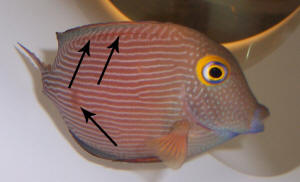 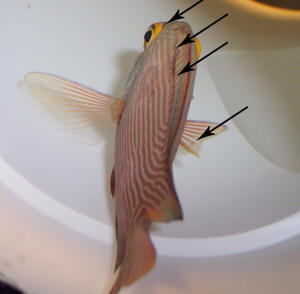
Re: Kole Tang Health Problem 12/8/11
Hello Again Bob,
<Adrian>
I didn't notice a reply to my 2nd email to you (but did on
the website).
<?! We respond directly to all>
My 3rd/last question is in regards to the color of the Kole tang,
on the under-side of the mouth and around the gills. In one of
the previous email pictures attached - you can see it has a shade
of blue/purple to it.
<Yes...>
I just did a water-change in the QT and I noticed this dark blue
was more pronounced - can you shed some light?
<Yes; is natural... comes/goes in terms of contrast, intensity
w/ the emotional state of the individual. BobF>
Regards,
Adrian
|
Kole tang in hospital tank
10/25/11
Hey Crew,
<TJ>
I e-mailed you guys a few months ago to clarify about an article and
Mr. Fenner responded, I had read his article on Kole Tangs, and his
recommendation was to skip the QT process with this species, but to use
a freshwater bath instead. I followed his advice, and everything was
going fine for a week or two. Then the Ich showed up. I have a 75
gallon aquarium, with a 20 long sump. 0 ammonia, 0 nitrites, 0
nitrates, pH is 8.1-8.2, constant 78 degree temp. The only tankmates
are a pair of ocellaris clowns, royal gramma, 3 green chromis, yellow
watchman goby/pistol shrimp pair, and a skunk cleaner shrimp. I have
approximately 65-70 lbs of live rock as well.
The Kole tang is the only one to show symptoms of Ich, but I never saw
him flashing against the sand or rocks. Occasionally I'd see him
rub his mouth against the rocks, but he was still aggressively eating
and grazing on the rocks. Other than the white spots, there were
basically no signs of any problems. Then last week he became very
lethargic and would still eat, but didn't seem as eager to be fed
as he previously was. I decided to pull out my hospital tank and treat
with hyposalinity. I have a cheap power filter, and the sponge and
"bio media" have been sitting in my sump for several months,
just in case I needed them. I set up my hospital tank (20 gallon long,
bare bottom with PVC elbows for hiding places, a heater, and the filter
with cycled media) and have all the fish in the hospital tank and will
let the tank sit fallow for 2 months. I lost one of the 3 green chromis
in the hospital tank last night.
Back to the Kole Tang. Starting last night, I noticed he was laying on
his side inside one of the PVC elbows, but he was still breathing. I
nudged the PVC and he started swimming upright and came out of hiding
for a little while, then went back in and laid down. I see my clowns
laying on their sides every night sleeping, but have never seen this
behavior with the Kole Tang, and was wondering if this is normal.
<Entirely normal; all Surgeonfishes lay down at night>
I just tested the hospital tank water and it showed no ammonia present,
but today he is still laying on his side. His color is darkening back
up, and he actually "looks" healthier than he did 2 days ago
when I decided to treat for Ich, but his behavior is somewhat
startling. Do you have any tips or suggestions (or explanations) for
what's going on?
<Just to urge patience... what are you treating the supposed Crypt
w/?>
I hope I've covered all my bases on the information you'd
need!
Thanks again, and I love your site!!!
-TJ
<Welcome. BF>
Re: Kole tang in hospital tank 10/25/11
Thanks for the quick response! I guess I forgot to mention that I am
going the hyposalinity route.
<Understood this. Won't effect a cure>
As far as the symptoms shown by the Kole Tang, it had white spots all
over his body by the end of the day. Usually in the mornings there
wouldn't be many visible white spots, but late at night they were
all over him. He also got very skinny and pale. I feed Omega One
pellets, instant ocean flakes (came with a bucket of salt), omega one
sinking algae wafers, and I offer him dried seaweed/Nori but he
won't touch
that for some reason.
<See WWM re Crypt, Tangs. B>
|
Kole Tang Disease: Crypt/Ich/Reading. Little Useful
Information.6/1/2009
<Hi>
I got my Kole Tang 3 weeks ago. He's just now eating algae
off the glass and rocks.
<Hmm... no quarantine? Read here:
http://www.wetwebmedia.com/QuarMarFishes.htm >
For the past few days he's had these white marks in his eyes.
He also has a white spot between his bottom fin and tail.
He's tail looks choppy too. You can see both in the
pictures.
<I see this.>
The other fish are doing fine. and look good.
<For now....>
Thanks,
<I'm going to assume you are asking what the white spots
are and how to treat them. your fish has Ich. Read here, and the
linked articles on the top of the page.
http://www.wetwebmedia.com/ichartmar.htm
http://www.wetwebmedia.com/ichart2mar.htm >
Nichole
<MikeV>
|
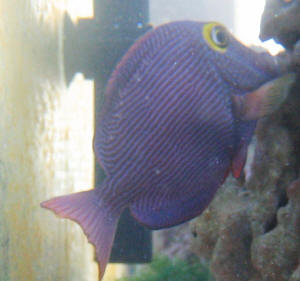 |
Re: Kole Tang Disease:
Crypt/Ich/Reading.6/1/2009
There is only one white spot.
<Unless it was just the picture, I saw more white spots on its
other side.>
It's bigger than what I have seen ich to look like. He hides
all day long under the rocks. Could he have hurt himself or am I
really dealing with ich?
<Physical injury is possible, what else is in the tank with
it? Based upon the information given, I still believe it is
likely Ich.>
Thanks
<MikeV>
|
Re: Kole Tang, lack of hlth., caring
6/13/09
Well the Yellow eye Kole is on it last breath. I'm not
sure what happened water conditions are good.
<...>
I never saw him eat so I guess I'll blame it on
that.
<... a poor choice of words, attitude or both>
He has these stringy red thing coming out of him and
he's in really bad shape, so I took him out of the
tank. Thanks,
Nichole
<Perhaps more reading... Bob Fenner>
|
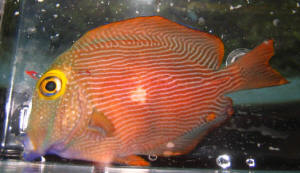 |
|
Chloroquine phosphate usage/dosage
2/13/09 I acquired a Kole recently, and put him into
quarantine where I've noticed two relatively small white patches on
him. About one month ago after reading Bob Fenner's writings here,
I acquired some Chloroquine phosphate from a Canadian pharmaceutical
company. It came in 250 mg tablets. My question is how to go about
trading him. The fish is in a 10 gallon quarantine tank with a seeded
filter, but I know that frequent water changes will be necessary.
Specifically, how do we administer the does which I believe is 10
mg/liter (380 mg/10 gallon tank)? <You could "grind up"
the tablet/s... with a pill crusher... or have a pharmacist do this for
you (grind, weigh)... "guess"/measure as to about the right
amount otherwise> This drug is not like copper. We have no way of
testing its level. As we will need to do water changes from time to
time, how can we be sure that the level is correct? <One can only
"guess-timate" presently. There is a broad range of efficacy,
safety> Your advice will be greatly appreciated as we would very
much like to save this fish. Thank you, Jeffrey Castaldo <And re the
"patches" period... I would not likely treat for
this/these... better to dip/bath and place this Ctenochaetus in your
main display. Bob Fenner>
Re: Chloroquine phosphate usage/dosage -
2/13/09 Based upon a dosage of 10 mg per 1 L, which is what I
have read here, 380 mg (1.5 tablets) would be correct, and easy enough
to attain accurately with a pill cutter. <We are in agreement>
However, having just acquired this fish, I am curious as to why you
recommend to just dip/bath the fish and place it into my main display
tank without the usual 30 day quarantine I usually adhere to, and what
is normally stressed here on WWW. <This genus is
"touchier" than "average"... and that you state you
have only a ten gallon to quarantine it in... My high confidence
opinion is that there is much less likelihood to be transmittal of
pests, parasites (excluded through preventative bath) than subsequent
damage to this specimen in a months isolation there> Without a
photograph, are you able to give me some insight as to what those
patches are? <Mmm, only guesses in either case. I have collected
Combtooth tangs in a few countries, though primarily in HI... these are
often hand-damaged through moving from hand netting (off a barrier,
mist net) to collecting/decomp. buckets... and later processing...
Often what one sees here are actual "fingerprints" on the
fishes' sides...> And when you recommend a dip/bath, are you
referring to plain buffered (8.4) freshwater, with Methylene blue,
Formalin, or? <I am referring to all of these possible protocols. I
would use pH adjusted FW, some MB and Formalin... the last with heavy
aeration> Also, I am still uncertain as how to go about keeping the
dose therapeutic when I need to make frequent water changes. I suppose
I could use Prime, but I am uncertain as to how to incorporate that
into the treatment. <A good question. I don't know either. Maybe
ask the folks at FishVet (.com)> I am sending this follow-up because
I do not fully understand, and want to administer the proper treatment.
Thank you very much for your assistance. Jeffrey Castaldo <A
pleasure to conspire with you, BobF>
Re: Chloroquine phosphate usage/dosage -
2/13/09 Thank you for clarifying this to me, and for your
excellent advice and honesty. I realize that there is no clear-cut
solution for all situations; many times we must learn through trial and
error. Best regards, Jeffrey Castaldo <Ah, yes... am doing my best
to share, warn folks of my too-many errors... so they can avoid these
trials. Cheers! BobF>
| Kole Tang... sick? 8/9/07 Hi!, I
wrote for the first time the other day about a multi-skimmer.
Thanks for the help on that! I ended up returning it for the Bak
Pak 2 but anyway... I have had this Kole tang for about four weeks,
two weeks in quarantine, and two weeks in my main tank. He is
eating great, browsing on algae, formula two etc. He and my coral
beauty were kind of getting into it the night before, but today
seemed fine. Lights came on at 11:30 and all was well. When I
looked in the tank at about two PM, my tang had these new spots on
him! I have been fortunate enough not to have had any diseases in
my tank, so I would like to get your opinion on what this could be,
disease or injury from coral beauty, or rock work? Water quality is
great. I am really concerned because it just showed up within a
couple hours. I appreciate the help!! Thanks, Jarod <Mmm...
can't make out much from this pic... This could be trouble (as
in Crypt or other parasite) or just night-time coloration... Please
do send along a better resolved image. Bob Fenner> |
|
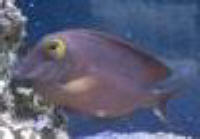
|
Kole tang ich update and macroalgae Hi Bob Fenner, I wrote
several weeks ago, several times, about my Kole tang with ich. Well, he
has been in his hospital tank for two weeks, with a gradual reduction
of spg to now 1.016 and temp at 82 degrees F. He is doing great! As of
yesterday, he had no more ich cysts present on his fins or body. He is
healthy and his color is really bright ! I feed him brine shrimp in the
morning, and a prepared frozen algae (mostly Spirulina) in the evening,
then again at night. He actually comes to beg when he sees me come into
the room. (Brine shrimp are his favorite food.) I suppose I will leave
him at this spg for another 3 weeks since the main tank will have been
fallow for 5 weeks at that time. Is this too long to leave him in this
low salinity water? (Total of 3-4 weeks in spg=1.016) <No
problem> About the main tank,... I have begun to stock the refugium
part of my sump with macroalgae (have only actually purchased 2
different kinds, but as of last count have 6 different kinds
present,....) Since I upgraded my lighting down there to 64W power
compacts (15 gallon refugium area), things have begun to pop up
everywhere. I have one kind of Halimeda which has very large
"leaves" and is beginning to cover up a small piece of coral
which has just began to extend its polyps for the first time. Both are
located on a piece of live rock I purchased back in April, they have
just never been under sufficient lighting. I would much rather the
coral get to growing, over the Halimeda, but is there any way to pick
the algae off the rock without harming it and "replant" it
somewhere else in the tank? <Best to make a small "chip"
off the rock with the holdfast mechanism of the Halimeda intact on
it> Thanks for the constant, consistent advice, The recovering pet
hospital, Jana <Thank you for the update on your continuing
progress, success. Bob Fenner>
Big Mistake - Ich Bob, I think I may have messed up! I
purchased a Kole tang, gave him a fw dip, and put him in quarantine. He
was there 12 days, but he was losing color and would not eat and was
getting real thin. I figured, 12 days, close enough and I thought
adding him to the main tank with all the LR would help. So I fw dipped
him again and put him in my main tank (90 gal, 90lbs LR, neon goby,
some snails and hermits - amm, nitrite/trate = 0, 82F, 1.023). Well,
just my luck (ignorance), he came down with ich. So I put him back in
quarantine and will begin copper treatment. I'm afraid that in
trying to help, I've unduly stressed this poor fish and have also
introduced ich to my main system!!! Arghhhh! <I would have very
likely done the same...> Should I raise the temp and lower salinity
and let the tank go without fish for a month before putting the tang
back in (if he doesn't starve to death in quarantine)? <Maybe...
I would wait, see if the fish develop ich there for now> Can I leave
the little neon goby in the tank, or would he serve as a host for the
disease? <Would serve as a host if ich virulent enough... as stated,
would wait at this juncture> Thanks in advance for any advice/help
you can give. Frustrated. <Steady on my friend. Bob Fenner>
Please, no lectures, Dad (Kole tang early introduction) Hi
Bob Fenner, In view of our country's latest tragedy, if you are not
answering emails, I understand, I don't feel much like working
right now either, but I have something that needs to be dealt with
immediately. <Am of the habit, practice of trying to do "simple
things" when in turmoil...> I bought a Kole tang this weekend,
and was concerned about handling him since their mouths are so
delicate, so I opted not to quarantine him,... or dip him. Alright.
Alright. I know, I have read it all. I know what I should have done,
but the fact of the matter is that I just couldn't bring myself to
watch him come onto the brink of death while swimming around in
freshwater. I just figured that the chances of me hurting him were
worse than the chance of him coming home with parasites. So I
acclimated him slowly to my tank, and there he is. Here are all the
specifics: He first had one white spot that sticks out like a grain of
salt on one of his fins, now he has a few more little ones close by the
first one. He took to my tank quickly. He eats all of the time, and I
really don't even have to supplement him, he usually ignores the
food I offer (which the cleaner shrimp gladly eats - Nori) and eats
things I can't see, and some things I can, off of the rocks. He is
very active, not scratching at all, and loves swimming in the strong
current I have flowing through the tank. I also have two damsels in the
tank. They are completely unaffected, of course. I have seen the
cleaner shrimp jump on the Kole tang and quickly clean him, but this
has only happened twice. Most of the time the shrimp just hangs out on
the Nori eating, eating, eating. All of my animals, even the ones not
in water, beg me constantly. There is no lack of appetite in my house,
that's for sure. The tank: 55 gal future reef, 75 lbs. live rock 40
lbs. of sand (very thick sand layer), some macroalgae, no amounts of
ammonia, or nitrate, has been running since April, 2 yellow tailed
damsels, 1 cleaner shrimp, 1 Kole tang, run Berlin method. Everything
is pointed to healthy, but he has the white dots and that's it.
Should I just wait and let the cleaner shrimp do his job, or should I
break everything down right now and get them all separated and treated?
Will the shrimp even do his job if he is eating too much? And if I do
have to let the tank go fallow to rid it of these Protozoans, can the
shrimp still hang out in there or not? Any advice would be appreciated.
Jana <I would likely just leave this fish in place. If it had much
of a "going" strength pathogen... your system would/will have
it by now. Please read: http://wetwebmedia.com/ctenocha1.htm Bob
Fenner>
Re: Update of Kole tang with ick Hello again, I am very sorry
about bugging you so much on this one. This is all my fault and I have
learned my lesson. You can lecture me all you want now, Dad. I deserve
it. <No fight, no blame> The Kole tang has, over the weekend
developed so many white spots. At least 8-10. I have the water temp up
to 82 and the salinity I am slowly dropping,... is at 1.022 right now.
All fish are the same, they all seem completely unaffected. I purchased
a Lysmata debelius this weekend, and he is doing good and helping clean
the tang. But why is it that when both of my cleaner shrimp jump on and
clean, they never pick off those little white crystals on the fish?
What are they cleaning? <What they can, want... other materials,
necrotic tissue> Things I can't see? And as far as lowering the
specific gravity and raising the temp of the tank, that's a quick
fix for now, but what about when things go back to normal conditions?
Will the Tomite stage of the Cryptocaryon life cycle still be present
in the tank? <A question of balance. If your fish livestock are
"healthier", the system more favorable to them... then no,
the ich/Cryptocaryon will not "achieve" epidemic
proportions> If I do have to resort to placing the Kole tang in a
hospital tank what water should I use for the hospital tank?
<Initially, the system water... this is detailed on the WWM
site.> My infected main tank water or my premix salt water outside
in the new garbage can? I realize he needs to be in water similar to
his own, but does this include infected water? And I realize I have to
dip him as well. Freshwater with adjusted pH and temp equal to that
from which he is coming and Methylene blue,....? I have some Rid-Ick
from my previous freshwater days which contains formaldehyde and
malachite green. Would this be safe to use for him as a dip? And if I
do have to let the tank sit fallow for a month or so, can my
invertebrates still stay and hang out in there? <Yes> I have read
nothing to the effect of them "carrying" or contracting these
sort of fish diseases. And during this "fallow" period if the
damsels were to be in this tank, yet not display any signs of the
Trophont stage on their bodies, would this necessarily mean the
Trophont stage of the parasite has died since it only lives for a short
time if it doesn't find a host? <No, only that you might not
actually see it... the damsels have to be pulled as well> Or is it
just safe to go ahead and take them out as well, and truly let the tank
go fallow? Also, could you please suggest a scientific journal article
or something similar on Cryptocaryon irritans or such. <A very good
general reference: Noga, Edward J. 1996. Fish Disease, Diagnosis and
Treatment. Mosby-Year Book Inc., St. Louis. 367pp. Just met this
gentleman at the recent MACNA XIII btw. Very complete work> The
internet is very helpful, but I really need to learn more about this
things life cycle in order to conquer it. (I have a degree in biology
and can understand most writings in this field, so fire away.) In fact,
since I started all of this marine tank insanity I am thinking of going
to get a Master's in the subject. Why not, I already spend most of
my free time studying this as it is! <Ah, perhaps I'll re-do my
"pitch" on this holociliate (my extant one pre-dates personal
computers... circa 1981 if memory serves> Again, Thank you so much
for your ongoing support and advice. I am very pissed at myself for not
quarantining this Kole tang, now he will be hurt more than he would
have been to begin with. And I hate to see any animal suffer for ANY
reason. Jana <Translate your agitation into positive action here...
You will understand and get beyond this situation. Bob Fenner>
|
|

